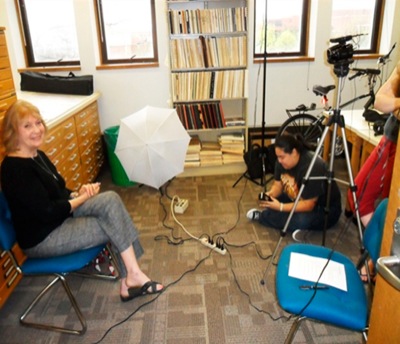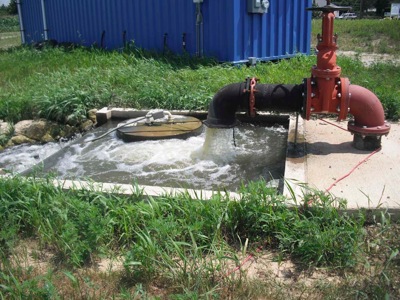Friday, September 27th, 2013
'Forgotten Histories' documents Fort's past
By William Kincaid

Submitted Photo
Ball State University students interview Fort Recovery State Museum Director Nancy Knapke for their documentary, "Forgotten Histories: The Battles of Wabash and Fort Recovery."
FORT RECOVERY - Most people don't know about Fort Recovery, says Jack Hemmelgarn in the new documentary "Forgotten Histories: The Battles of Wabash and Fort Recovery."
"They come here, and they say, 'that can't be true because if it was that important, I would have heard about it,' " Hemmelgarn, a member of the of the Fort Recovery Historical Society, says. "But it's the most historical place nobody's ever heard of."
What Hemmelgarn is referring to is a series of cornerstone battles responsible for the westward expansion of the United States - the focus of the documentary produced by students at Ball State University, Muncie, Ind. The DVD is available at the Fort Recovery State Museum for a donation.
Spanning 26 minutes - a length required for submission to several film festivals - "Forgotten Histories" is a succinct, informative summation of the Battle of the Wabash in 1791, also known as St. Clair's Defeat, and the Battle of Fort Recovery in 1794.
The Battle of Wabash was very historic, museum director Nancy Knapke says.
"This was just a huge event, the greatest loss of the United States Army and the greatest victory of a native force over a white, invading force in the history of the world," she adds.
The documentary reveals the fledgling nation's encroachment on territories inhabited by Native Americans, resulting in the Northwest Indian War. The U.S. suffered its worst defeat under General Arthur St. Clair at the Battle of Wabash, but American forces - then commanded by General Anthony Wayne - triumphantly struck back against the coalition at the Battle of Fort Recovery.
"For a set of students to come in and kind of take that information and distill it down and make it an interesting story that has a little bit different slant on it, I think they did a really nice job," says Chris Keller, an archaeologist at Ball State University's Department of Anthropology.
Keller and university colleagues Dr. Mark Groover and Dr. Cailin Murray successfully applied for a $33,000 internal university grant to help produce the documentary and guided the students' efforts.
Employing a series of images, maps and stock footage of re-enactments - some mined from the local museum's archive - with multiple voice-over narrators and music, the film effectively tells the stories and creates suspense in under 30 minutes.
"We knew we wanted interviews interspersed with the telling of the history interspersed with whatever footage was here at the museum," Keller says, adding the students were disappointed they couldn't fit every interview into the documentary.
One of the goals of the project was to present a balanced perspective of the conflicts, which was achieved in part by adding the opinions of George Ironstrack, a member of the Miami Tribe of Oklahoma.
In the film, Ironstrack says some people would prefer to gloss over the defeat of St. Clair because it's the dirty underbelly of American history. But it's also the reality of how this country got to where it is today, he explains.
"It was an empire, and in many ways behaves like an empire today," he says. "If people don't like that, it's perhaps because they fail to deal with their past of being an empire. But if you don't acknowledge that you were an empire and you took territory by conquering it, then how can you acknowledge today ways in which your nation behaves in an imperial fashion?"
The biggest misunderstanding people have about the Native Americans is viewing them as living exclusively in the past and not interacting with or even realizing they exist today in a real sense, Ironstrack says.
"The Indians were misused by the white man, in my opinion," Bob Freemyer of the historical society states in the film.
Fellow historical society member Neil Diller says the government is very embarrassed by the defeat at Wabash.
"Otherwise this story would be a much bigger thing in history," he says, "So what do you do with the bad stuff you don't like? You just kind of don't say much about it."
The Ball State students, mostly junior and senior anthropology and history majors, logged 2,177 hours and learned video editing and interviewing skills while producing the film.
"It made me proud of both the history and our students," Keller says of the finished product.
The work was submitted to multiple film festivals, aired on PBS of Muncie and was shown at a Fort Recovery High School student assembly last spring in conjunction with the 100th anniversary celebration of the Fort Recovery Monument.
The collaboration between the university and the village of Fort Recovery is mutually beneficial, Keller said. Ball State's anthropology department was recently awarded two National Park Service American Battlefield Protection Program grants totaling $131,532 to continue archaeological research and preservation work in the village.
"Honestly, the students feel like kings and queens when they come over here," Keller says. "They love to come over here because everybody is very appreciative of what they're doing, and they feel special and they feel like what they're doing is important."





